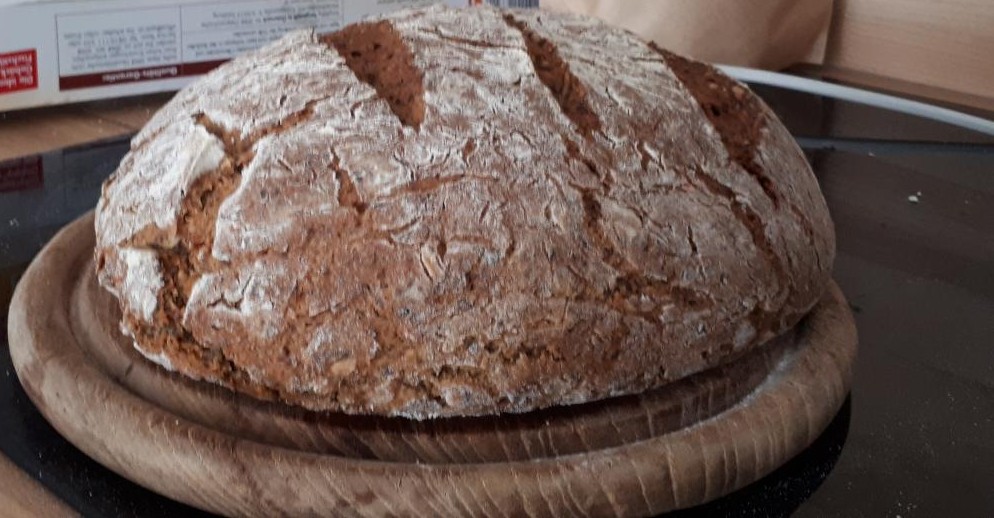I just thought it might be fun to chat generally about making these proteins from scratch, and hear what people's experiences are with it.
Tofu:
I've been watching Will It Tofu videos lately and it inspired me to make some pumfu from scratch because it's a bit cheaper that way and you also get the byproducts which can be reused too.
It's really fun to do because watching the milk separate into curds feels like mad science or witchy or something. It really turned out great, except I only got about 2/3rds the amount of pumfu out of process as they said I should. The only thing I can think of is maybe I didn't blend it well enough, so I'm going to try some tricks to blend it better next time.
Anyway, you get 3 products from it:
- Tofu - pumpkin seed tofu is so good, it's just expensive. It's just fattier than soy, so it really lends it to sausage-like preparations. I spice it like chorizo, pan fry it as a crumble and serve it over a tostada with black bean refritos and some veggies. I try not to overpower the flavor of the pumfu itself. It's killer.
- Okara - This is the pulp leftover when you squeeze out the nutmilk. You can find recipes for it. A lot of people bulk out baking recipes with it. I combined it with a mashed potato and veggies and made a potato/okara pancake with it and dressed it with some thai chili sauce. The nuttiness of the pumpkin seed really came through, and it's really good. I'll need to add a bit of binder next time though, because it was pretty fragile. I've also heard you can rehydrate the okara, add nootch, and have a nice ricotta replacement, and tasting the raw okara, that makes sense. I may try it.
- Whey - This is leftover when you press the curds into tofu. This makes a nice broth, and it added some depth to my instant ramen.
Seitan:
I've been making this from scratch for years. It's pretty easy.
I've tried both the "wash out" method where you wash the starch out of whole flour, and the method where you just start with gluten flour. I don't feel like the final product benefits much from the extra work of washing it out, so I just do it lazy-style.
There's lots of recipes out there for different mix-ins and different methods to cook. Personally, I like a very chewy, spongy, fluffy seitan, so I don't mix-in any other flours and then I boil it unwrapped in small pieces so it can fluff out a bit. Then I'll just do other prep from there. I love a nice fried buffalo seitan "wing."
I find that adding other flours (chickpea is common) makes a final product that's more like tofurky. That has it's place, but I'm a bit of a sicko and want the spongy stuff.
Tempeh:
I never made this from scratch, but if anyone has, I'd love to hear your experiences.
Has anyone out there experimented with this stuff? Going forward I'm definitely going to be pressing more weird tofus. I accidentally got too many red lentils a while back, so that's probably going to be my next tofu.
pumpkin seed tofu is conceptually mindblowing to me. i knew you could do most soy bean fermentation recipes with other beans, had no idea this was possible though. that's so cool.
Yeah, it kinda blew my mind too. It's also interesting how close the whole process is with cheese making.
I really hope rarer tofus become a trend as veganism rises, because there's a huge range of what you can do before you even start cooking. Seed tofus are really interesting, because it opens up this whole new category of rich/fatty proteins.
i watch so many videos on making tempeh from scratch but i'm still too intimidated to try it

any you recommend? or is it the kinda thing you just watched and moved on?
the last one i remember watching was this one and it looks like a really cool process but in general i still haven't tried making any beans that aren't canned yet, but i hope to soon!
I found a YouTube link in your comment. Here are links to the same video on alternative frontends that protect your privacy:
I used to work for a local small batch fresh tempeh company, I was more involved with delivering than production but I learned a few things
We mostly made chickpea tempeh but we also sometimes made black bean tempeh and white bean tempeh and they're all made the same way
Basically the process starts with cooking the beans then mixing in the mycelium (mushroom) starter and putting the mixture into molds which are then floated in a water bath heated to a specific temperature and covered before being left to sit to allow the mycelium to grow in the beans, once that's done you refrigerate the tempeh to stop the growth and that's about it
A black bean tempeh is pretty intriguing. I could really see crisping it up with some chili and lime and it being substantial. I think if I take the plunge, I might start with it.
I'm lowkey jealous of some of these comments, lmao. All I've ever had is grocery store stuff.
I made tacos with the black bean tempeh and that turned out well
My main way of using all the tempeh is to cut it into slices and fry it in oil first, then I could do a few different things with it
Most basic was just taking those slices and pan frying or baking them real quick to reheat before using them on a sandwich, one of my favorites is coating the tempeh in Korean BBQ sauce and adding some kim chi to the sandwich
The other thing I'd do a lot was take those slices and cut them up into smaller pieces before frying them in oil a 2nd time, then I'd add soy sauce, chili crisp and whatever other seasonings I have that work and cook all of that into the tempeh, then I can store most of that for later meals while using some to season vegetable (napa cabbage is one of my favorites for this) stir fry which I then have with rice
i've made tofu and gluten many times and i've also made tempeh from scratch multiple times using both whole/split soybeans, soy pulp leftovers 豆渣 from soymilk making (what you call "okara"), lentils and split yellow peas. it's pretty easy. the most annoying part is taking the husk off of soaked beans, which is why using split beans or soy pulp is easier. you need tempeh starter (ragi tempeh) which you can find at indonesian supermarkets, and you also need a stable temperature of around 30-35 degrees for the first day or so until it starts generating its own heat, so it's easier to make it in the summer if you don't live in a tropical climate.
the reason i'm not making it anymore is that i now live in a neighbourhood with lots of indonesian people, so it's very easy to find freshly made (still warm and breathing) tempeh super cheap.
I'm really going to have to try that this summer. It's definitely the right temp range here, though if it has to be a full day, I worry about over night a bit. I've never really had fresh made tempeh. Is it a lot better?
Sounds like a dream to be able to pick it up on the corner.
it will still ferment in lower temps, just goes quicker if it's the right temp and less chance of failure. after a day or so the fermentation starts to produce heat of its own.
yeah fresh tempeh is nicer, less stale and more beany fresh. and getting it from the indo corner store from a big stack of newly fermented tempeh is amazing

Made washed flour seitan a couple times recently. It's cheap, simple and delicious. downside being how fucking long it takes. The thing that really bugs me though, is that it feels incredibly wasteful. Like I can't help but wonder how much water I'm using or how much bread I could be making instead.
Yeah, if you can manage to just buy the gluten flour, it makes it soooo much easier. It really lowered the effort threshhold to where I make it more often.
I have nothing of substance to add to this chat, a little brew pub in Baltimore made these BLTs once, out of tempeh bacon, It was absolutely amazing, and I'm a big meat eater. I've tried to reproduce the sandwich half a dozen times with every version I can get my hands on, none of it is even close. I asked them where it came from, apparently their chef makes it himself.
I have friends out there, do you remember the name of the place? I might check it out one day.
Nepenthe Brewery in Hampden on Falls road.
I've been there half a dozen times, their beer is decent by brewpub standards their menu is always off the fucking hook.
I don't think I've seen the BLT on the menu since, But there's usually something proper vegan on there.
I'm pretty new to the meat alternative game but I have discovered that making seitan in a pressure cooker is a massive game changer, much more tender, much shorter time.
How much does it cost you, ballpark, to make a block of pumpkin seed tofu? I'd like a fattier protein source just for convenience. Never tried a non-soy tofu.
I have a good seitan recipe which I will post if anyone's interested. The trick is you do the stretch and braid technique and then pop it in the instant pot. Comes out really dense with fibers like muscle, can be pulled into a pulled pork type texture if you want. No fuckery with tinfoil wraps or whatever because of that and the pressure.
I found a YouTube link in your comment. Here are links to the same video on alternative frontends that protect your privacy:
Ballpark, in the US? Everything goes right, $5 for 370g (12oz+). That much pumfu is easily as (or more) filling than a typical 16oz soy tofu block.
You can order 5lbs of seeds from a non-Amazon bulk-seller for like $25 after shipping/tax. 1 pound of seed yields that 12oz of pumfu per multiple sources (mine was a bit less, but I needed to blend better). You can get even cheaper, if you wanted to do massive quantities of seeds, but I doubt any home cook would. 5lbs of seed from Amazon only goes as low as $30, so that's not the way to go.
Pumfu in the store costs $7 for 8oz, so you're talking $10.50 for the same amount. So you save 50% making it yourself, and if you use the okara (pulp), you can squeeze more value out of it. I was worried that the okara would be a bit of bullshit no-waste filler ingredient, but I was wrong. It has a legit nuttiness that comes out when cooked, and a nice "milkiness" when uncooked (but a bit grainy).
I've never seen that braiding technique for seitan. I'm 100% going to try that next time, because I always like a good tweak.
eesh, $6/lb is still a lot for a homemade staple. I eat a lot of seitan and take about a year and a half to go through a 50lb bag of gluten, but I think seeds would go rancid in that quantity / time. I might try it as a treat eventually though. When I first saw non-soybean tofus in the store I assumed they were for Whole Foods suburbanites scared of soy turning them gay, this is the first time I've heard that they actually have some advantages
Oh for sure, it's not an every day food. It's a treat. Because it's a bit heavier, I doubt I'd want it more than once a week. But yeah, I got two meals out of it between the okara and pumfu, with the pumfu one being kinda decadent. But as far as economics go, nothing's ever gonna beat gluten flour or dried whole beans.
But absolutely you'd have to watch out for rancidity with seeds. That's why I said it's probably not worth getting more than a 5lb bag, unless you have a chest freezer and are going to be freezing the seeds to preserve, at which point you're just paying back your bulk savings with the electric bill.
The two types of non-soy tofu I see at wholefoods are pumfu, which we've discussed, and chickpea tofu. The chickpea tofu, I believe is usually Burmese Tofu. Which if you haven't had that, it's suuuper different. It's somewhere between polenta and tofu. It's starchy because they use whole chickpea flour, not separated curds. BUT if you like that, it's extremely easy and economical to make at home, because you just stir water and chickpea flour (aka gram flour or besan) in a pot until it congeals, then let it set in the fridge.
You can make chickpea tofu that's more like what soy tofu is, but I don't think that's what you usually find in the market.
I found a YouTube link in your post. Here are links to the same video on alternative frontends that protect your privacy:





